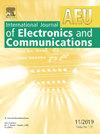A concurrent dual-band LNA for 2.4 GHz and 5.2 GHz application based on active inductor technic
IF 3.2
3区 计算机科学
Q2 ENGINEERING, ELECTRICAL & ELECTRONIC
Aeu-International Journal of Electronics and Communications
Pub Date : 2025-08-20
DOI:10.1016/j.aeue.2025.155993
引用次数: 0
Abstract
A concurrent dual-band low-noise amplifier (DB-LNA) based on active inductors was designed to operate at 2.4 GHz and 5.2 GHz to meet IEEE 802.11 n standards. The conventional common source cascode topology without the source degeneration inductor is implemented in the gain control stage. Input impedance matching is achieved with a single-path circuit resonating at two distinct frequencies, while output matching is accomplished using band-pass and band-stop filters. Active inductors replace traditional passive inductors to reduce layout area, and their high Q factor minimizes power consumption. Furthermore, gate noise is suppressed with a capacitor between source and gate in the input stage. The results show that the proposed DB-LNA has gains of 17.2 dB and 12.0 dB at 2.4 GHz and 5.2 GHz, respectively, with noise figures of 3.5 dB and 4.7 dB. The and of the DB-LNA are both less than −10 dB at both frequency bands. The 1 dB compression points are −23.9 dBm at 2.4 GHz and −18.7 dBm at 5.2 GHz, with third-order input intercept point values of −13.1 dBm and −8.3 dBm, respectively. The total power dissipation is 15.72 mW with a 1.2 V supply, and the layout area is 0.32 mm.
基于有源电感技术的2.4 GHz和5.2 GHz并发双频LNA
设计了一种基于有源电感的并发双频低噪声放大器(DB-LNA),工作频率分别为2.4 GHz和5.2 GHz,满足IEEE 802.11 n标准。在增益控制阶段,采用传统的共源级联码拓扑结构,不加源退化电感。输入阻抗匹配是通过在两个不同频率下谐振的单路电路实现的,而输出匹配是通过带通和带阻滤波器实现的。有源电感取代了传统的无源电感,减少了布局面积,其高Q因数最大限度地降低了功耗。此外,在输入级中,在源和栅极之间使用电容抑制栅极噪声。结果表明,该dB - lna在2.4 GHz和5.2 GHz频段的增益分别为17.2 dB和12.0 dB,噪声系数分别为3.5 dB和4.7 dB。dB - lna的S11和S22在两个频段均小于−10 dB。1 dB压缩点在2.4 GHz时为- 23.9 dBm,在5.2 GHz时为- 18.7 dBm,三阶输入截获点分别为- 13.1 dBm和- 8.3 dBm。在1.2 V电源下,总功耗为15.72 mW,布局面积为0.32 mm2。
本文章由计算机程序翻译,如有差异,请以英文原文为准。
求助全文
约1分钟内获得全文
求助全文
来源期刊
CiteScore
6.90
自引率
18.80%
发文量
292
审稿时长
4.9 months
期刊介绍:
AEÜ is an international scientific journal which publishes both original works and invited tutorials. The journal''s scope covers all aspects of theory and design of circuits, systems and devices for electronics, signal processing, and communication, including:
signal and system theory, digital signal processing
network theory and circuit design
information theory, communication theory and techniques, modulation, source and channel coding
switching theory and techniques, communication protocols
optical communications
microwave theory and techniques, radar, sonar
antennas, wave propagation
AEÜ publishes full papers and letters with very short turn around time but a high standard review process. Review cycles are typically finished within twelve weeks by application of modern electronic communication facilities.

 求助内容:
求助内容: 应助结果提醒方式:
应助结果提醒方式:


